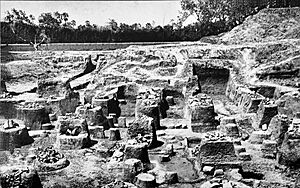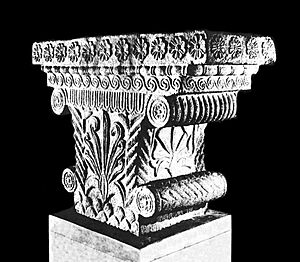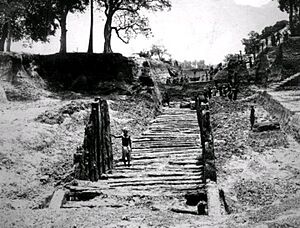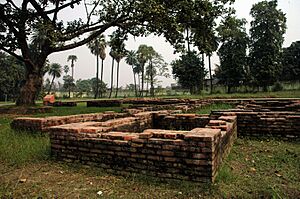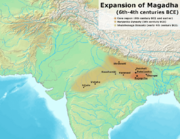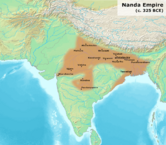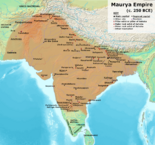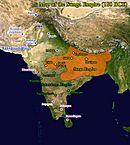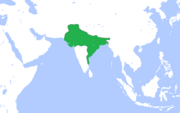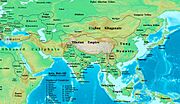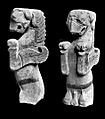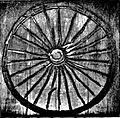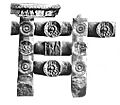Pataliputra facts for kids
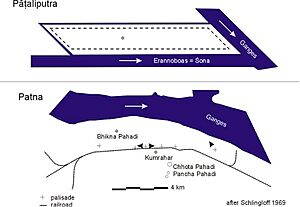
Plan of Pataliputra, compared to present-day Patna
|
|
| Alternative name | Pātaliputtā (Pāli) |
|---|---|
| Location | Patna district, Bihar, India |
| Region | India |
| Coordinates | 25°36′45″N 85°7′42″E / 25.61250°N 85.12833°E |
| Altitude | 53 m (174 ft) |
| Length | 14.5 km (9.0 mi) |
| Width | 2.4 km (1.5 mi) |
| History | |
| Builder | Ajatashatru |
| Founded | 490 BCE |
| Abandoned | Became modern Patna |
| Associated with | Haryankas, Shishunagas, Nandas, Mauryans, Shungas, Guptas, Palas |
| Management | Archaeological Survey of India |
Pataliputra (pronounced PAA-tah-lee-POO-trah) was a very important city in ancient India. It was located right next to where the modern city of Patna in Bihar, India is today.
The city was first built around 490 BCE by a ruler named Ajatashatru from the Magadha kingdom. It started as a small fort called Pataligrama near the Ganges river. Later, King Udayin made Pataliputra his capital. He moved the capital from Rajgriha because Pataliputra was in a better, more central spot. It was also located where two rivers, the Son and the Ganges, met.
Pataliputra became the capital city for many powerful empires in ancient India. These included the Shishunaga Empire, Nanda Empire, Maurya Empire, Gupta Empire, and Pala Empire. During the Maurya period, it was one of the biggest cities in the world. A Greek diplomat named Megasthenes wrote that Pataliputra was one of the first cities to have a very good system of local self-government.
Archaeologists started finding the remains of this ancient city in 1892. They found strong walls, including some made with wood.
Contents
What's in a Name?
The name "Pataliputra" comes from two Sanskrit words. "Pāṭali-" refers to the pāṭalī tree, which is a type of flowering tree. "-putrá" means "son."
So, one idea is that the city was named after the pāṭalī tree. Another story says that Pataliputra means "the son of Pāṭali," who was a princess. Since it was first known as Pāṭali-grāma (Pāṭali village), some experts think Pataliputra just means "Pāṭali town." The city was also called Kusumapura, which means "city of flowers."
A City Through Time
Pataliputra was not mentioned in old writings until the early Jain and Buddhist texts. These texts describe it as a village called Pataligrama. Archaeological findings show that the city started growing around the 3rd or 4th century BCE.
In 303 BCE, the Greek historian Megasthenes wrote about Pataliputra in his book Indika. He said the king of Pataliputra really liked the Greeks.
The city's central location in northeastern India made it a perfect capital. It was at the meeting point of the Ganges, Gandhaka, and Son rivers. This made it like a "water fort" and helped it control river trade. Pataliputra was a major center for trade and attracted many merchants and thinkers, like the famous Chanakya.
Two important Buddhist meetings were held here. One was the Second Buddhist Council during the reign of Emperor Ashoka. The other was the Third Buddhist Council.
Jain and Hindu writings say that Udayabhadra, the son of Ajatashatru, was the first king to make Pataliputra the capital of Magadha.
Capital of the Maurya Empire
During the time of Emperor Ashoka in the 3rd century BCE, Pataliputra was one of the world's largest cities. It had a population of about 150,000 to 400,000 people. The city was huge, covering about 25.5 square kilometers (about 10 square miles). It had a circumference of 33.8 kilometers (about 21 miles). The city was shaped like a parallelogram and had 64 gates.
Pataliputra was most successful when it was the capital of the great Mauryan Emperors, Chandragupta Maurya and Ashoka.
Megasthenes, a Greek ambassador, lived in Pataliputra and wrote about its greatness. He called it "Palibothra." He described it as a very large and rich city. He also said the king had a huge army of 600,000 foot-soldiers, 30,000 cavalry, and 9,000 elephants.
Another historian, Arrian, quoting Megasthenes, said the city was about 10 miles long and 1.75 miles wide. It had a ditch 600 feet wide and 45 feet deep around it. The city wall had 570 towers and 64 gates.

Strabo added that the city walls were made of wood. These wooden walls have been found during excavations in Patna.
A writer named Aelian described the Indian palaces as even more splendid than those in Persia. He mentioned beautiful parks with tame peacocks and pheasants.
Under Emperor Ashoka, many wooden structures in Pataliputra were slowly replaced with stone. Ashoka was a great builder. He might have even brought in skilled workers from other countries to help build royal buildings. The Pataliputra palace shows influences from Persian palaces.
Capital of Later Dynasties
Pataliputra also became an important Buddhist center with many monasteries. It remained the capital of the Gupta dynasty (3rd–6th centuries) and the Pala Dynasty (8th-12th centuries).
When the Chinese traveler Faxian visited the city around 400 A.D., he found the people rich and kind. He noted that nobles and citizens had built several hospitals. These hospitals offered free treatment and help to the poor, sick, and disabled from all over. Doctors would check diseases and provide food, drink, and medicines.
Why the City Declined
When another Chinese traveler, Xuanzang, visited Pataliputra in 637 CE, he found the city in ruins. He wrote that the old city had been empty for many years. Only a small walled town remained by the Ganges river, with about 1,000 people. Most of the city's old buildings were destroyed, with only their foundations left.
Pataliputra's decline likely started before Xuanzang's visit, around the 300s. After about 600 CE, there are no signs of people living there for a thousand years.
One reason for its decline was a change in the Ganges river's path. By Faxian's visit around 400 CE, the city was about 10 km (6 miles) south of the Ganges. Since Pataliputra relied on river trade, being far from the river probably hurt its economy. A general decrease in international trade around the end of the Gupta period also played a part.
A huge flood likely destroyed the city in the late 500s. An old Jain text describes a terrible flood on the Son River that destroyed Pataliputra. This flood happened after 17 days and nights of heavy rain. The Son river's flooding caused the Ganges to overflow, and Pataliputra was flooded from many sides. The text says the city was rebuilt afterward.
Another possible reason for its decline was destruction by invading Hunas in the early 500s. A thick layer of ashes found at a building in Kumrahar suggests it might have been destroyed by fire.
Pala Dynasty and Later
Pataliputra seems to have recovered a little during the early Pala period. An inscription from the early 800s describes Pataliputra as a busy river port and royal camp. It mentions many boats, elephants, horses, and soldiers gathered there.
However, archaeologists have not found much evidence from the Pala period at Pataliputra. At least at Kumrahar, there are no signs of people living there again until the 1600s.
In 1559, an Italian book mentioned a powerful Indian kingdom with its capital at Palibotra. Later, Sher Shah Suri made Pataliputra his capital and changed its name to modern Patna.
City Layout
Even though parts of the ancient city have been dug up, much of it is still buried under modern Patna. Several places have been excavated, including Kumhrar, Bulandi Bagh, and Agam Kuan.
During the Mauryan period, the city was shaped like a parallelogram. It was about 2.5 kilometers (1.5 miles) wide and 15 kilometers (9 miles) long. Its wooden walls had 64 gates. Archaeologists have found parts of these wooden walls over several kilometers. However, stone walls have not been found.
Excavated Sites of Pataliputra
- Kumhrar
- Bulandi Bagh
- Agam Kuan
Pataliputra: A Capital City
- Pataliputra served as the capital under various Indian dynasties
-
Pataliputra was the capital of the Haryanka dynasty and the Shishunaga dynasty of Magadha.
-
Pataliputra was the capital of the Nanda Empire.
-
Pataliputra was the capital of the Maurya Empire.
-
Pataliputra was the capital of the Shunga Empire.
-
Pataliputra was the capital of the Gupta Empire.
-
Pataliputra was the capital of the Pala Empire.
Important Discoveries
-
Pataliputra griffin statuette.
See also
- Azimabad
- Names of Patna
- History of Patna




